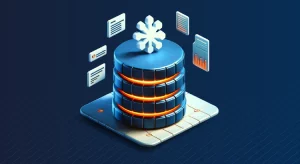
Snowflake Roles

Snowflake is a platform for storing data in the cloud. It has different roles to help manage databases and keep data safe.
Snowflake helps organizations manage user permissions and control their data efficiently. It uses Role-Based Access Control (RBAC) for this purpose.
RBAC allows organizations to maintain precise control over their data. This article will explain the basics of Snowflake roles. It also explains how they can simplify Snowflake database management by using RBAC principles.
Understanding Snowflake Roles
Snowflake provides several built-in system-defined roles that grant specific privileges and access rights to users. These roles are designed to cater to different levels of responsibility within an organization. Let’s take a closer look at the key Snowflake roles:
- ORGADMIN: The ORGADMIN role grants full control over all objects and users within an organization. It is the highest level of privilege in Snowflake.
- ACCOUNTADMIN: The ACCOUNTADMIN role manages all objects and users within an account. It has the ability to create and modify databases, warehouses, and other account-level objects.
- SYSADMIN: The SYSADMIN role is responsible for managing system-level objects and tasks, such as creating and modifying warehouses, monitors, and resource monitors.
- SECURITYADMIN: The SECURITYADMIN role focuses on security-related tasks, including managing users, roles, and privileges within an account.
- USERADMIN: The USERADMIN role is responsible for managing users and roles within an account, but with limited privileges compared to the SECURITYADMIN role.
- PUBLIC: The PUBLIC role is automatically granted to all users in Snowflake and provides basic access to objects that are explicitly granted to this role.
Example:
-- Grant the SYSADMIN role to a user GRANT ROLE SYSADMIN TO USER john_doe;
Leveraging Built-in Views and Functions
Snowflake provides a set of built-in views and functions that allow administrators to manage roles effectively. These views and functions offer insights into role assignments, privileges, and hierarchy.
Information Schema Views
- INFORMATION_SCHEMA.APPLICABLE_ROLES: This view displays the roles that are applicable to the current user, including inherited roles.
Example:
SELECT * FROM INFORMATION_SCHEMA.APPLICABLE_ROLES;
- INFORMATION_SCHEMA.ENABLED_ROLES: This view shows the roles that are currently enabled for the user’s session.
Example:
SELECT * FROM INFORMATION_SCHEMA.ENABLED_ROLES;
System Functions
- CURRENT_ROLE(): This function returns the current active role for the user’s session.
Example:
SELECT CURRENT_ROLE();
- HAS_ROLE(): This function checks if a user has been granted a specific role.
Example:
SELECT HAS_ROLE('SYSADMIN');Implementing RBAC with Snowflake Roles
Snowflake’s RBAC model allows organizations to assign roles to users based on their job responsibilities and access requirements. By granting appropriate roles to users, administrators can ensure that individuals have the necessary privileges to perform their tasks while maintaining data security.
Example:
-- Create a custom role for data analysts CREATE ROLE data_analyst; -- Grant specific privileges to the data_analyst role GRANT USAGE ON WAREHOUSE analytics_wh TO ROLE data_analyst; GRANT SELECT ON DATABASE analytics_db TO ROLE data_analyst; -- Assign the data_analyst role to a user GRANT ROLE data_analyst TO USER jane_doe;
This example involves creating a custom role named data_analyst. We then assign certain privileges to this role, like using a specific warehouse and accessing a designated database. We give a user the data analyst role so they can analyze data within a specific scope.
Best Practices for Managing Snowflake Roles
To effectively manage Snowflake roles and ensure a secure and organized database environment, consider the following best practices:
- Follow the principle of least privilege: Grant users only the minimum set of privileges required to perform their tasks.
- Regularly review and audit role assignments to identify and remove any unnecessary or outdated permissions.
- Use role hierarchies to simplify permission management and inherit privileges from parent roles.
- Implement separation of duties by assigning different roles to users based on their job functions to prevent conflicts of interest.
- Utilize Snowflake’s built-in views and functions to monitor and troubleshoot role-related issues.
Example:
-- Create a role hierarchy CREATE ROLE junior_analyst; GRANT ROLE junior_analyst TO ROLE data_analyst; -- Grant specific privileges to the junior_analyst role GRANT SELECT ON TABLE analytics_db.public.sales TO ROLE junior_analyst;
In this example, we create a role hierarchy by granting the junior_analyst role to the data_analyst role. This allows junior analysts to inherit the privileges of the data_analyst role while having additional specific privileges granted to their role.
Conclusion
Snowflake’s built-in roles and RBAC capabilities provide a powerful framework for managing database access and ensuring data security. Organizations can make their Snowflake database management processes more efficient. They can do this by understanding the different Snowflake roles, using built-in views and functions, and following best practices. This will help them maintain detailed control over user permissions.
Implementing effective role-based access control not only enhances security but also simplifies administration tasks, enables scalability, and facilitates compliance with industry regulations. Snowflake’s role management system is easy to use and flexible. It helps organizations focus on getting important information from their data. It also makes sure that the right people can access the right resources.
Organizations can improve their Snowflake database security and compliance with DataSunrise tools. These tools are easy to use and include features for auditing, masking, and ensuring compliance. Contact our team for an online demo to learn how DataSunrise can strengthen your Snowflake environment.
